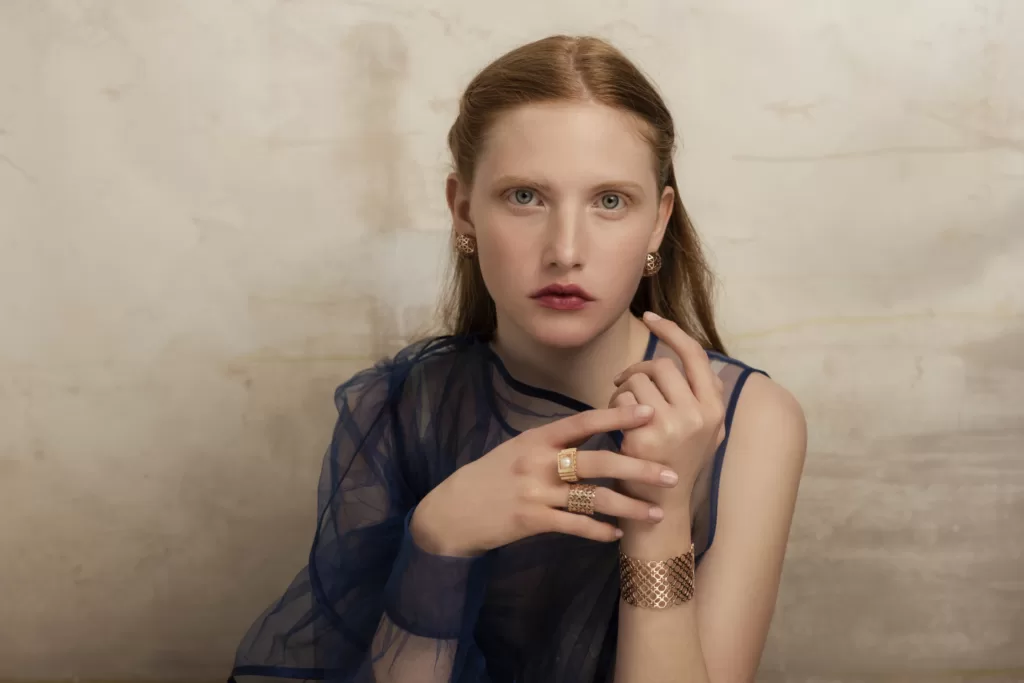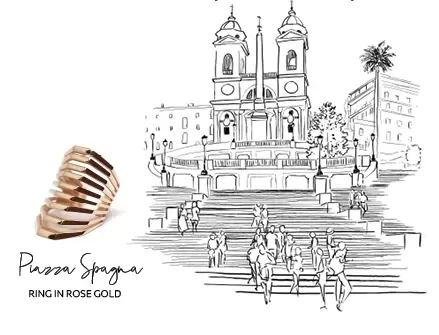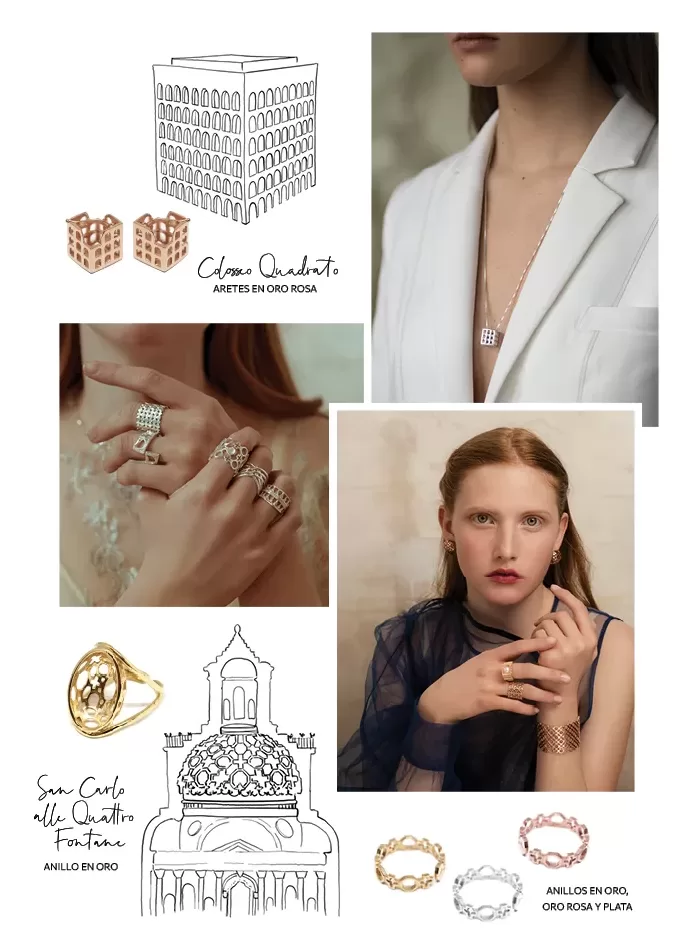Founded by Giulia and Costanza, Co.Ro. is a Rome-based jewelry brand inspired by the geometric elegance of iconic landmarks like the Colosseum and the Pantheon. Their boutique near Piazza Navona showcases jewels collections crafted with a blend of traditional Italian craftsmanship and their unique perspective as architects.


Co.Ro.
Jewels
Architecture to Atelier
From the ancient aqueducts to the most modern villas, there’s a classic beauty in the geometry and forms of Italian architecture. Some of these constructions are well-known, such as the Colosseum or the Pantheon, and others seem to be a well-kept secret, known only to locals, still waiting to be discovered.
These landmarks were precisely the inspiration for Giulia and Costanza, the founders of Co.Ro., a Rome-based jewelry brand inspired by architectural design. As they call it, it’s Architecture-à-porter. Located in the city center and nearby Piazza Navona, the jewelry boutique showcases the latest collections resulting from traditional Italian craftsmanship combined with their unique perspective as architects. Upon entering, I’m greeted by Costanza, one of the two creators of Co.Ro., who kindly invites me to their small but charming atelier on the second floor. It’s a unique space, their workspaces filled with postcards and drafts on the wall and some wax models here and there. It’s just beautiful. We sit on a cozy velvet sofa to start our conversation while natural light fills the room, reflects on the light-colored tiles, and bounces on the deep blue walls.
What is the story behind Co.Ro.? How did it all begin?
It’s the story of both a passion for architecture and jewelry and the story of a friendship, mine and Giulia’s. We were together in high school and had always been friends. So much so that Co.Ro. stands for Collegio Romano, the acronym for the square where our school was located when it all started.
Later and during college, I started attending the Fashion and Costume Academy in Via della Rondinella. I would tell Giulia what we were doing in the afternoons, and I taught her techniques, like lost wax casting techniques that we still use today. Later, we also attended other courses with other manual processes to make jewelry. At the same time, we continued to do architecture, so the passions came together on their own. We started making jewelry inspired by our studies and selling it a bit for fun to our college friends. We registered the brand in 2011, naming it Co.Ro. Studio because we still thought it would be our studio for both jewelry and architecture. It was not just the world of jewelry that we were focusing on at that time.
How did you decide to focus exclusively on jewelry?
We worked for a jewelry designer, Bernard Delettrez, who is very successful and talented. We always went with him to fairs around the world, and back then, our daily attention was focused on the world of goldsmithing since we designed both for him and our brand. Besides, we also learned how the company works and how to manage everything because it’s not only about knowing design. Thanks to him, we grew and structured a bit. When we graduated, we disconnected ourselves a bit from architecture, and it was good because it’s very demanding; we couldn’t do both. Architecture theory is lovely, and so is practice—designing is beautiful. It shaped us, and although we did complete some architecture projects, it was very exhausting. In the end, it was always more enjoyable to make jewelry.

At what point did you decide to take the leap and create a brand of your own?
Very spontaneously, because we didn’t have a proper business plan or company project; only our passion made it a reality. It was something that made me feel relaxed due to my character. Because if I’d had to plan all the stages of a company’s development, I probably would have been terrified. It was a step-by-step process, first having our small business and a few clients. We understood how it works, gained experience, and then decided to take real action with all its consequences. For me, it was much better that way and more aligned with our character.
What were some of the biggest challenges you encountered along the way?
One of the fundamental steps was to open this place where we are now, because we previously had a small shop in Monti, which was not precisely a store. For us, it felt more like a game while we were there, and instead, it was different when we came here to Via della Scrofa. The moment we opened the boutique, we then had a rental fee, other responsibilities, and so on. That was undoubtedly the biggest challenge. We began to ask ourselves, “will we be able to carry it out every day, build an audience, and achieve our goals?” By the time we arrived here, we had graduated and had stopped working for Bernard. We were only dedicating ourselves to Co.Ro., and we thought, “Okay, now is definitely when it starts.”
This place is beautiful. How did you come across it?
We love it, il nostro piccolo mondo (our little world). It was the first space we saw, and I remember when we went up to the second floor, Giulia and I looked at each other, and we both said, “This is it!” It’s our world now. We thought about painting the floor blue because we wanted to recreate the sensation of walking on water, reproducing the blue of the sea in Capri. But the original floor was so precious, and we didn’t want to cover it up. So we painted the walls blue, and it became the color representing us.

What is your creative process like?
We design together, and both Giulia and I do the drawing. We start with an idea from either of us, and then it’s always complemented by the other. It’s beautiful to design together because it gives us a broader vision with more details. When doing it alone, you have only one point of view; you will surely see more detail between the two. And it’s even more fun. Giulia and I are very close friends, and it’s beautiful because we can bounce ideas off each other, “How is it? What do you think?” That is the best part.
Then there is the whole analysis part, the research of the design details, and then the realization. Modeling, casting, finishing, and engraving; there are many different parts. We do many of the processes ourselves. Other parts of the process we do together with ceramists and artisans. We love the Italian goldsmith tradition very much, and we want everything to be absolutely made in Italy. It’s called Co.Ro. also because we like the idea that behind each object, there is a coro of artisans, a group of creators that we direct as if they were a choir, and us, the orchestra directors.
What techniques and materials do you use? Which ones do you like the most?
We have a laboratory where we do the castings, the finishes, and the galvanizing. Instead, everything that’s related to design, prototyping, enamels, pearl assembly, and stones, we do it here in the studio. We have commissions that mix both techniques, so we start on the computer, and then we give it that manual touch by modifying it by hand.
We use silver, plated gold, and rose gold. There is also black rhodium in some collections, which has a very particular dark shine. To keep prices not too high in the larger pieces, we use gold-plated bronze. On request, we also make gold; for example, we make engagement rings and unique wedding rings. We also use natural and cultured pearls and gemstones, especially garnets, peridots, diorites, and topazes. Additionally, we use enamels that we make ourselves directly here. We often use the technique of cathedral enamel, which is very beautiful because it looks as if it were made of nearly transparent glass, and I also love working on it; it’s very relaxing.
How does the dynamic work between you two?
In the creative part, we are absolutely in harmony; we do it together. On other things, each one of us has our own focus, we are starting to specialize a bit. For example, Giulia is in charge of online communication and marketing. I dedicate myself more to photos, and now I have started doing them myself, so I specialize in the photography sector. I think it’s fun, too. We are also growing. There are people who help us with the management of the boutique. We are fortunate to have found very good people, serious, very kind, even on a human level. When you find the right people, you’re lucky.
Of all your pieces, which is the most important? What are your favorites?
Certainly, the one that represents us the most is the Gasometer collection of industrial archeology. The ring was one of our first pieces, and it’s certainly very popular. More than a collection, it’s a family that we continue to expand. With Bernard, we designed a collection that lasted two seasons and then ended. But we don’t want ours to end. So for us, even the Gasometer that we have been manufacturing for ten years is still a current piece.
Then there are the ones that I particularly love. The Kyoto ring, the entire collection dedicated to Japan and the East, and the contrast between the pearl and more geometric structures. I love this collection. Also, I really like the ring with the perspective of Borromini. Because behind each piece, there is a whole reasoning and time devoted to studying them. For example, that’s a ring that we went crazy about since we had to create a perspective in a tiny space without it becoming an unusable ring because it’s too tall. It was all a matter of space, of details; we had to study it well. So I’m very fond of it. When I see it, I realize that it’s just what I wanted to convey with my idea, so I am satisfied. It’s exactly as I had imagined it.

It’s amazing how each piece has a story behind it and a lot of development…
Yes, even in the Pantheon ring, we have engraved a phrase from Memoirs of Hadrian referring to the Pantheon, “I felt responsible for the beauty of the world.” It’s such a beautiful structure, and that’s precisely what we think when we see it. That’s why it looks great in the ring. It’s the synthesis of the entire structure and the inspiration behind it. It’s definitely a piece I’m very attached to. The ring inspired by Casa Malaparte is another piece I’m very fond of because they’re memories of our life experiences. Giulia and I always went to Positano and Capri. So when I go out with the ring, I remember the feeling of being in the villa looking at the water below.
In addition to using architecture as inspiration, what do you seek to convey with your pieces and artwork?
We are inspired by a place, an architectural detail. We have slightly more geometric collections, but they are mostly older collections. Now, we try to stay more on the subject of architecture. And what we would like to do is, in addition to creating an emotion because you enjoy a beautiful object and want to wear it, we also like the idea that it hides a memory or a discovery.
For example, the Palazzetto dello Sport by Pier Luigi Nervi is a beautiful structure in Rome that’s almost abandoned, and not all Romans know about it. Certainly not all Italians, nor foreigners. We like the idea that curiosity arises when you see our ring and want to look for it. It conveys part of our passions, so it’s not only a beautiful object but also one that hides a story and an emotion behind it. We want to provoke the desire to go discover, see, have your own experience in that place, and then remember it through the ring. We want to create a series of emotions.
Costanza talks to me with a contagious passion and with the brilliance and charm of someone who loves what she does. In the way she shares the story behind each piece, you can perceive the love and care that goes into each of the different collections they have designed. Each piece’s volumes, spaces, and forms of architecture are reinterpreted uniquely. When I leave the boutique, now in the company of a beautiful ring inspired by Piazza di Spagna, I get the feeling that wearing one of these pieces is like taking a part of Rome with me.


Brand: Co.Ro.
Founders and designers: Costanza De Cecco and Giulia Giannini
Location: Rome, Italy
Product type: Handcrafted architecture-inspired jewelry
corojewels.com
@co.ro.jewels
A version of this article appears in print, in Issue 1 of Álula Magazine, with the headline: “Co.Ro. Jewels. Architecture to Atelier”.



